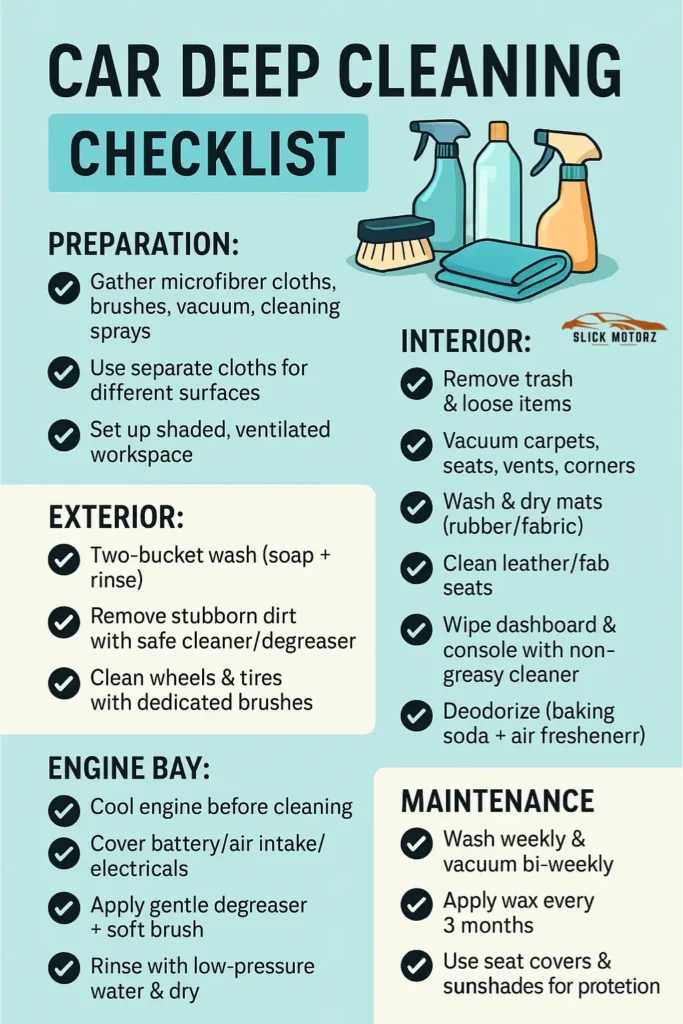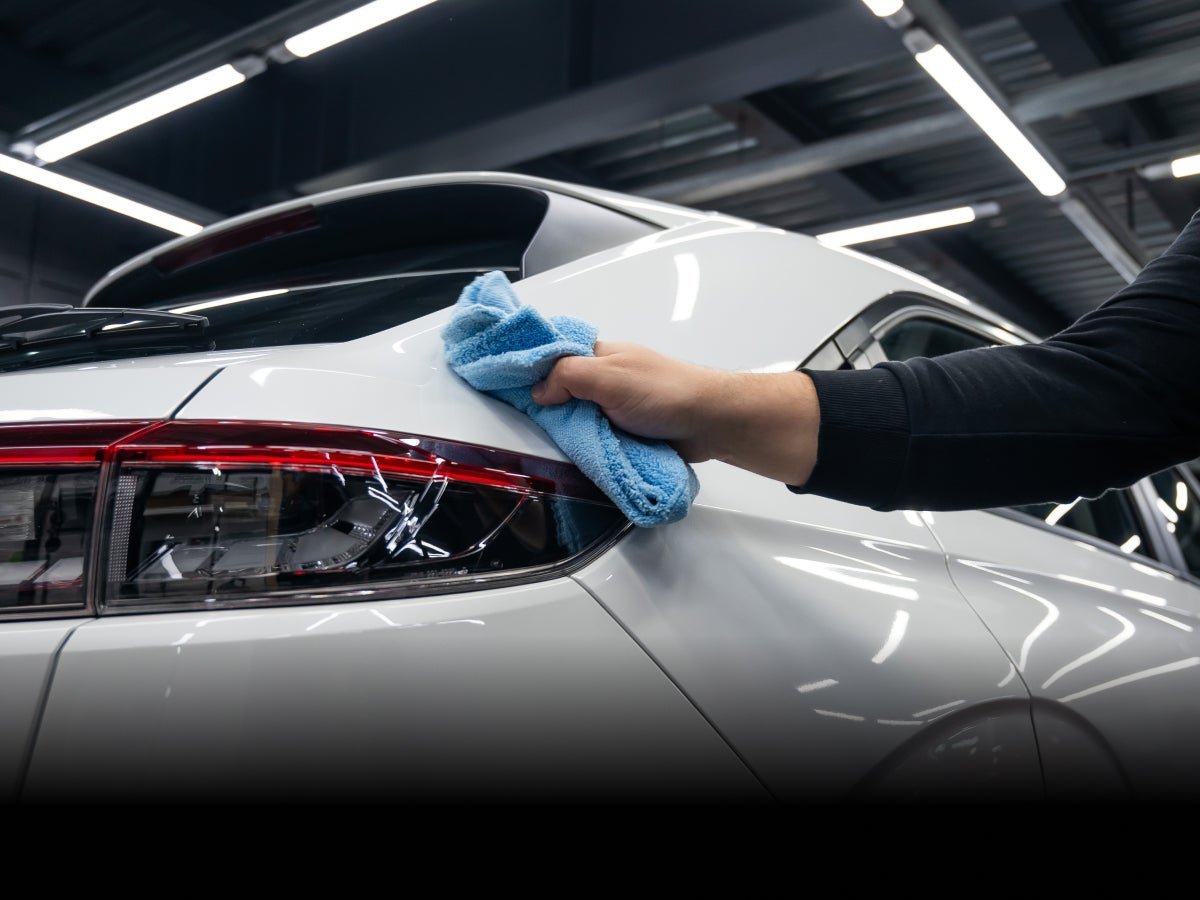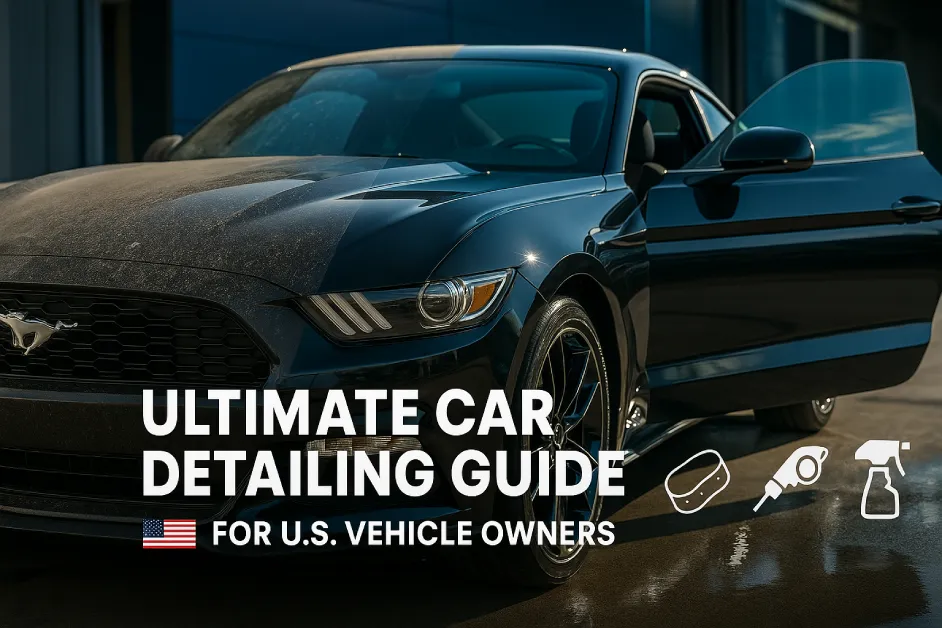Your car deserves more than just a quick wipe-down. Imagine stepping into a vehicle that feels fresh, spotless, and truly cared for every time you open the door.
Deep cleaning your car isn’t just about looks—it’s about protecting your investment, improving your driving experience, and even boosting your mood. In this ultimate guide to car deep cleaning, you’ll discover simple, effective steps to transform your car inside and out.
Whether you’re tackling stubborn stains, dust buildup, or odors, this guide will give you the confidence and knowledge to get professional-level results at home. Ready to give your car the deep clean it craves? Let’s dive in.
Preparing For Deep Cleaning
Preparing your car for a deep cleaning session is the first step to achieving a spotless result. This stage helps organize your tools and set a clean area to work. It makes the cleaning process smoother and more effective.
Good preparation also protects your car and yourself. Taking time here saves effort later.
Gathering Essential Supplies
Collect all cleaning materials before starting. Basic items include microfiber cloths, brushes, vacuum cleaner, and cleaning sprays. Use separate cloths for different surfaces to avoid cross-contamination. Ensure you have trash bags to remove debris. Having everything ready stops interruptions during cleaning.
Setting Up Your Workspace
Choose a shaded, well-ventilated area to clean your car. Direct sunlight can dry cleaning products too fast, leaving streaks. Ensure the ground is flat and clean to avoid dirt blowing onto your car. Arrange your supplies within easy reach. This setup helps keep the process organized and efficient.
Safety Precautions
Wear gloves to protect your skin from harsh chemicals. Use eye protection if you handle sprays or powders. Keep cleaning products out of the reach of children and pets. Read labels carefully and follow instructions. Never mix chemicals, as this can cause dangerous reactions. Proper safety ensures a risk-free cleaning session.

Credit: www.youtube.com
Exterior Cleaning Techniques
Cleaning your car’s exterior is key to maintaining its look and value. Dirt, dust, and grime can damage the paint and cause rust. Using the right cleaning techniques keeps your car shiny and protected. This section covers simple but effective methods for deep cleaning the outside of your car.
Follow these steps to remove dirt safely and restore your car’s finish. Each technique targets specific areas, from the body to the wheels and headlights. Clean regularly to enjoy a fresh, polished ride.
Two-bucket Wash Method
Use two buckets to wash your car without scratching the paint. One bucket holds clean water for rinsing your wash mitt. The second bucket contains soapy water with car shampoo. Dip the mitt in the soap, wash a section of the car, then rinse it in the clean water. This method prevents dirt from returning to the car’s surface.
Removing Stubborn Dirt And Grime
For tough dirt, use a gentle car-safe cleaner or degreaser. Spray on the dirty areas and let it sit for a few minutes. Then scrub lightly with a soft brush or sponge. Avoid harsh chemicals that can damage paint or trim. Rinse thoroughly to remove all residue.
Cleaning Wheels And Tires
Wheels and tires collect brake dust and road grime quickly. Use a wheel cleaner designed for your wheel type. Spray it on and let it work for a moment. Scrub with a wheel brush to remove dirt. Clean tires with a tire brush and soap. Rinse well to leave them looking fresh and new.
Restoring Headlights
Headlights get cloudy over time, reducing light output. Use a headlight restoration kit or a simple polish to clear them. Clean the surface, apply polish, and buff with a soft cloth. This improves visibility and makes your car look newer. Regular care keeps headlights bright and safe.
Interior Deep Cleaning
Keeping your car’s interior clean is key to a fresh and comfortable ride. Deep cleaning the inside removes dust, dirt, and stains hidden in corners and crevices. It also helps maintain your car’s value and extends the life of its materials. This guide breaks down the essential steps to clean every part of your car’s interior thoroughly.
Vacuuming And Removing Debris
Start by removing all loose items from your car. Use a vacuum with multiple attachments to reach under seats and between cushions. Focus on corners and air vents where dirt gathers. A handheld vacuum or brush helps lift stubborn debris. Take your time to ensure no crumbs or dust remain.
Cleaning Floor Mats And Carpets
Take out the floor mats and shake them to remove loose dirt. Wash rubber mats with soap and water, then dry completely. For carpet mats, use a carpet cleaner or shampoo to remove stains. Scrub gently with a brush and rinse well. Let them air dry before placing them back inside.
Leather And Upholstery Care
Use a soft cloth and a cleaner designed for leather or fabric seats. Test the cleaner on a small spot first. Clean leather seats gently to avoid cracks. For fabric, scrub lightly and blot stains with a damp cloth. Apply a conditioner to leather to keep it soft and prevent drying.
Dashboard And Console Detailing
Dust the dashboard, vents, and console with a microfiber cloth. Use a small brush to clean buttons and crevices. Apply a non-greasy cleaner to wipe surfaces without leaving residue. Avoid harsh chemicals that can damage plastics. Keep the dashboard looking new and free of fingerprints.
Deodorizing And Air Freshening
Eliminate odors by airing out the car with windows open. Use baking soda on carpets and seats to absorb smells, then vacuum after a few hours. Place a car air freshener or natural scent like essential oils inside. Regular deodorizing keeps your car smelling clean and inviting.

Engine Bay Detailing
Engine bay detailing is a key part of deep cleaning your car. A clean engine bay helps your vehicle run cooler and looks great. Dirt, grease, and grime can build up over time. Removing these contaminants improves engine performance and longevity. This section explains how to clean the engine bay safely and effectively.
Preparing The Engine Area
Start by making sure the engine is cool. A hot engine can cause burns and damage during cleaning. Remove any loose debris, like leaves or twigs, by hand. Cover sensitive parts such as the battery, air intake, and electrical components with plastic bags. This prevents water from causing damage. Keep the car in a well-ventilated area and wear gloves for protection.
Safe Cleaning Methods
Use a gentle degreaser designed for engine cleaning. Spray the degreaser on dirty areas and let it sit for a few minutes. Avoid harsh chemicals that can harm engine parts. Use a soft brush to scrub stubborn grime lightly. Rinse the engine bay with low-pressure water. High-pressure water can force moisture into sensitive areas. Dry the engine bay with a microfiber towel or air blower.
Protecting Engine Components
After cleaning, apply a protectant spray on plastic and rubber parts. This helps prevent cracking and fading. Avoid spraying on metal parts to prevent buildup. Check that all covers and caps are secure before starting the engine. Regularly cleaning and protecting the engine bay keeps it looking new and running smoothly.
Tools And Products
Deep cleaning a car requires the right tools and products. Using proper items makes the process easier and more effective. Choosing quality tools helps protect your car’s surfaces. The correct products remove dirt without causing damage. This section covers essential kits, detailing tools, and cleaning agents for car deep cleaning.
Recommended Cleaning Kits
Cleaning kits often include all basics for a thorough job. They come with brushes, cloths, and sponges. Some kits also have cleaning solutions and wax. Kits designed for cars save time searching for individual items. Choose kits that match your car’s cleaning needs. Look for kits with microfiber towels for scratch-free cleaning. Ensure the kit has a variety of brushes for different surfaces.
Best Detailing Tools
Detailing tools help reach tight spots and clean well. A soft-bristle brush works well for dashboards and vents. Use a foam applicator for applying wax or polish. A vacuum with small nozzles removes dirt from seats and carpets. Use a microfiber cloth to wipe and dry surfaces. A pressure washer can clean wheels and undercarriage. Tools should be gentle to avoid scratches or damage.
Choosing The Right Cleaning Agents
Select cleaning agents based on the surface and stain type. Use mild soap for general cleaning of paint and glass. Upholstery cleaners remove dirt from fabric seats. Leather cleaners keep leather seats soft and clean. Avoid harsh chemicals that can damage paint or interiors. Always test new products on a small area first. Choose eco-friendly products for safer, green cleaning.

Credit: detailingexperts.ca
Professional Detailing Insights
Professional detailing offers valuable insights into deep cleaning cars. Experts use advanced tools and products. They know how to clean every part of a car carefully. Their skills bring out the best shine and freshness. A professional detail can extend your car’s life and maintain its value.
Choosing a professional service can save time and effort. Professionals handle tough stains and hard-to-reach areas well. Their work often lasts longer than DIY cleaning. Understanding when to hire a pro helps you keep your car in top shape.
When To Seek Expert Help
Consider professional detailing after heavy use or long periods without cleaning. Deep stains or odors need expert care. Complex areas like engine bays or leather seats require special techniques. Professionals fix damage that home cleaning cannot. Seek help before small problems become costly repairs.
Cost Expectations
Professional car detailing costs vary by service level and car size. Basic packages start low, but full details cost more. Prices range from $50 to $300 or higher. Extra services like paint correction or odor removal add to cost. Comparing local shops helps find the right price for your needs.
Benefits Of Professional Services
Experts use high-quality products that protect your car’s surfaces. Their attention to detail results in a thorough clean. Professional cleaning improves car appearance and comfort. It also helps maintain resale value. Regular professional detailing protects your investment long-term.
Maintenance Tips
Maintaining a clean car after a deep cleaning session helps keep it fresh and protected. Simple habits improve your car’s look and value over time. Follow these maintenance tips to enjoy a spotless ride longer.
Regular Cleaning Schedule
Set a weekly day for washing your car. This prevents dirt build-up and stains. Use mild soap and soft cloth to protect paint. Clean the interior every two weeks. Vacuum seats and mats to remove dust and crumbs. Regular cleaning stops grime from settling in hard-to-clean places.
Quick Daily Upkeep
Spend a few minutes daily tidying your car. Remove trash and wipe dashboard with a microfiber cloth. Keep windows clean by using a glass cleaner. Check for spills and clean them immediately. Small efforts daily save time and effort later.
Protective Measures For Longevity
Apply wax to your car’s exterior every three months. Wax shields paint from sun and rain damage. Use seat covers to protect upholstery from wear and stains. Park in shaded areas to avoid sun damage. Use sunshades to keep the dashboard cool and prevent cracks.

Credit: www.cars24.com
Frequently Asked Questions
How To Really Deep Clean Your Car?
Vacuum seats and mats thoroughly. Clean surfaces with appropriate cleaners. Shampoo carpets and upholstery. Wipe windows inside and out. Wash and dry the exterior carefully. Use detailing brushes for vents and crevices. Finish with a protective wax coat for shine and protection.
How Much Does It Cost To Do A Full Detail On A Car?
A full car detail typically costs between $150 and $300, depending on the vehicle size and service depth. Prices vary by location and specific treatments included.
What Is The 2 Bucket Method For Car Detailing?
The 2-bucket method uses one bucket with soap for washing and another with clean water for rinsing the wash mitt. This prevents dirt from scratching the car’s paint. Adding grit guards helps trap debris, ensuring a safer, cleaner wash that protects your vehicle’s finish.
What Are The 4ps For Car Wash?
The 4Ps for car wash are Product, Price, Place, and Promotion. They guide service quality, cost, location, and marketing strategies.
Conclusion
Deep cleaning your car keeps it fresh, comfortable, and well-maintained. Regular care prevents damage and saves money over time. Use simple tools and follow clear steps for the best results. A clean car improves your driving experience every day. Start your deep cleaning routine today and enjoy a spotless ride.















